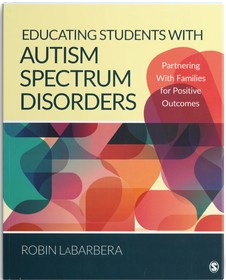
Teachers and parents who work together can make a world of difference. Research shows that when teachers and parents of children with learning differences collaborate, it benefits the students’ academic and social progress; the child’s academic and social skills not only improve, but so does the entire family’s well-being.
Robin LaBarbera (M.A. ’00), an associate professor and director of special education in Biola’s School of Education, recently published a textbook to help educators understand the importance of collaborating with families of children who have autism spectrum disorders (ASD). In Educating Students with Autism Spectrum Disorders: Partnering with Families for Positive Outcomes, LaBarbera presents practical classroom strategies for educating children with ASD, as well as case studies based on real interviews with teachers and parents. Biola Magazine recently connected with LaBarbera about ASD, her book and what she learned in the process.
Autism spectrum disorders seem to have grown in prominence and prevalence in recent decades, but many people don’t fully understand what these disorders are or how they impact people. How would you explain autism?
A commonality among children on the autism spectrum is that they may display social communication difficulties in varying degrees. Impairments in this category include deficits in social-emotional reciprocity, nonverbal communication behaviors used in social interaction, and developing, maintaining and understanding relationships. By social difficulties, we mean more than just having a sense of shyness or inclination toward introversion. Impairments in this area must be present in the early developmental period; they should cause significant impairment in important areas of daily functioning and they should be beyond what is expected for children at that developmental level.
Social reciprocity refers to the back-and-forth flow of social interaction. Children who have impairments in social reciprocity prefer to avoid social games, to participate more in solitary activities. They may not notice another person’s lack of interest in the focus or topic of conversation, or they might fail to notice another person’s distress when it occurs. All of these deficits can contribute to an unsuccessful social exchange.
Individuals with ASD are reported to have difficulty interpreting nonverbal communication from others, such as those conveyed through body language, facial expressions and gestures during social interactions. Non-verbal listener behaviors that convey an interest in the speaker include the body, head or both being oriented toward the speaker, looking at the speaker’s eyes or mouth, periodic smiling, raised eyebrows, head nodding and even vocalizations such as “mmm hmm.” Behaviors that seem to show disinterest include diverting eye contact away from the speaker, leaning one’s head on their hand, making audible sighs, yawning or raising eyebrows without a smile. Individuals with ASD can have di culty understanding what such nonverbal signals mean.
Why is it important for the general public, not just educators, to know about autism spectrum disorders? What are some of the most common misconceptions about ASD?
It’s important to know that what comes naturally to some children, without conscious thought on the part of the child, may need to be taught specifically to students with ASD and can often be the cause of “social awkwardness” you might see in someone with ASD.
A commonly held misconception is that individuals with ASD do not want to socialize with others. In reality, we often hear that these children or adults do have a desire for friends, but unwritten social codes that are readily understood by others seem indecipherable to them. It is true that they can seem uncomfortable in social settings and have difficulty making friends, but it may not be true that they have no desire to engage in social interactions.
As an educator, what are some of the most important things to consider when teaching students with ASD?
Students with ASD may display a number of characteristics that make it challenging for teachers to address their academic needs. Many students with ASD have difficulty with verbal or auditory information that has been read or heard, and therefore, visual supports are often necessary. Others have challenges with explaining the main idea of a text or drawing inferences, for example, and would require some level of support. Young students with ASD may have difficulty imitating others, which presents challenges learning to produce words by blending sounds, for example, and would again, require instructional supports. Difficulty with social interactions might make participation in group-work settings a challenge and therefore the teacher should make adaptations and modifications for this type of instruction if necessary.
Remember that students with ASD have difficulty understanding and remembering lengthy verbal instructions. Keep verbal instructions brief and consider pairing verbal instructions with visual supports as well. Keep your language simple and concrete. Most importantly, make sure the work environment is organized.
You mention how children with ASD have strong visual skills. How can visual aids be used to help with their learning?
I strongly recommend that using visual aids be the first thing you try with a student with ASD for instruction in any content area. Written or picture cues can help students with ASD to learn many different skills, from academic to social, behavioral and self-management. Information presented orally may pose problems for students with ASD. It can be difficult for them to process oral language and it may be difficult for the student to attend to relevant information and block out background stimulation. Using visual supports helps the individual with ASD focus on the message. Visual aids can range from simple to abstract. You can use real objects or situations, copies, color photographs, color pictures, black-and-white pictures, line drawings or written language.
Visual supports can be used to accomplish a variety of things in the classroom. They can be used to organize the student’s activity, through daily schedules, activity checklists, calendars or choice boards. They can be used to provide directions or instructions for the student, through things such as visual displays of assignments, file cards with directions for specific activities or tasks or written instructions for learning new information. They can also be used to label objects, charts, containers, lists or message centers.
In your book, you focus on the connection between teachers and students’ families. Do you think this interaction is currently lacking? Why is this so important?
This interaction is most definitely lacking, despite the fact that the IDEA (Individuals with Disabilities Education Act) mandates parent involvement in the education of students with special needs. The importance of parent participation is well documented in the literature, with research linking parent involvement to positive outcomes such as improved academic and social skills and enhanced family well-being.
Additionally, parents are often well- educated about ASD and their child and they are therefore able to serve as a great resource to schools. Parents of children with ASD often engage in an intense process of self-education when their child receives a diagnosis. It is quite likely that parents have acquired such extensive knowledge about ASD that they can be on near-equal footing with the education professionals in terms of their knowledge base. Schools would do well to capitalize on such rich resources and engage in sharing information between partners for maximum benefits to children’s academic and social development. Unfortunately, there are many barriers to successful collaboration. These barriers are highlighted in the book, as well as considerations for overcoming many of the barriers, so that our students with ASD receive the ultimate benefit.
What has been the most interesting or enlightening thing you learned as you interviewed parents and educators for your book?
I asked parents what they would want their child’s teacher to know about collaboration. Two meaningful quotes stand out to me:
“Teachers don’t think to include me as much as I would like. Teachers don’t have as much education about ASD as I do. Many teachers hold the view that parents should ‘just be parents’ instead of empowering them to be meaningful partners in the educational process.”
“I really, really, really want to communicate with you. I know you are busy, but please tell me about my son’s day — every day. If it was a great day, tell me why; if he had a rough day, tell me about it, and let’s spend time talking about how to deal with it in the best way. Together we can come up with solutions so that the next day is just a little better.”
These two quotes reveal to me that parents do, in fact, want to participate. And I know that they feel that school-family collaboration isn’t going well, and they want that to change.
ABOUT THE EXPERT
Robin LaBarbera (M.A. ’00), associate professor and director of special education in Biola’s School of Education, is a proud advocate for individuals with learning differences and their families. She has a Ph.D. in education from Claremont Graduate University and an M.A. in autism/applied behavior analysis from Arizona State University. Her book, Educating Students with Autism Spectrum Disorders: Partnering with Families for Positive Outcomes, was published by Sage Publications in January 2018. Follow her on Twitter @doktarobin or read her blog at thespecialedprofessor.com.
 Biola University
Biola University


